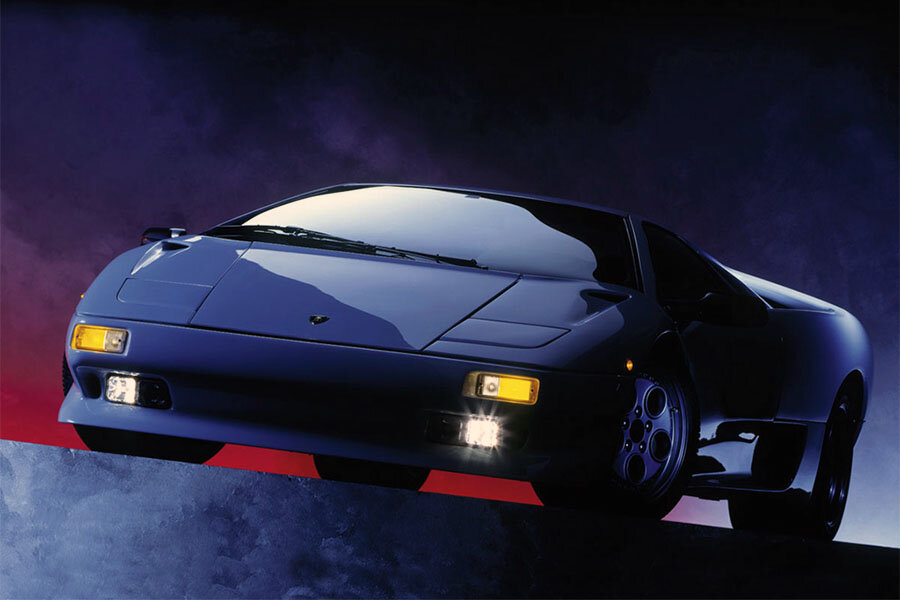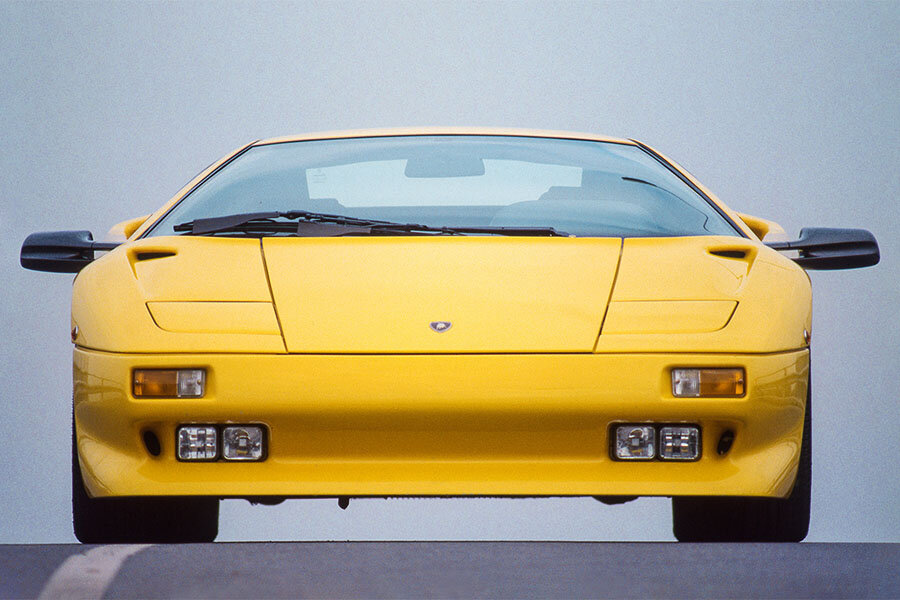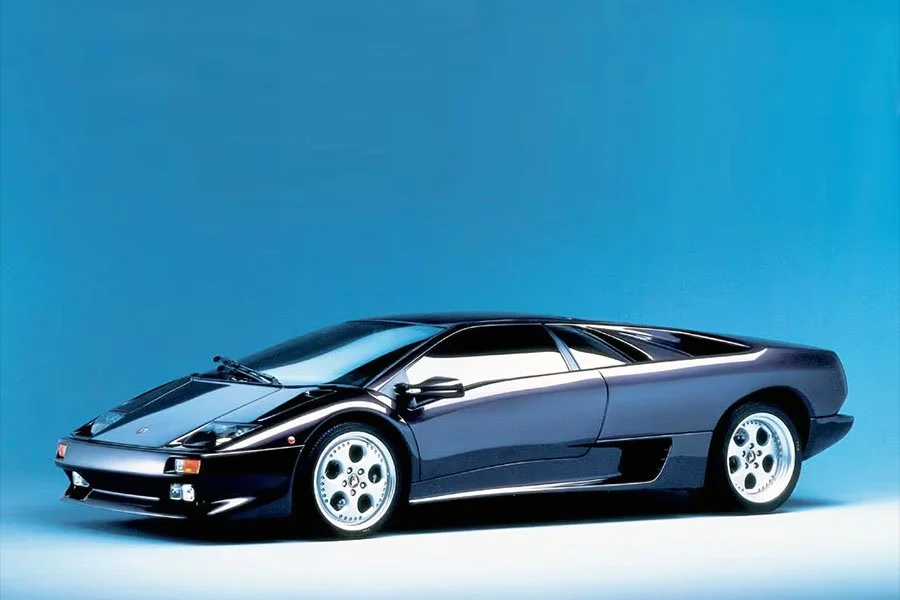Guide: Living Up to the Hype - a Historical & Technical Appraisal of the Lamborghini Diablo & Diablo VT
/BACKGROUND
Ferruccio Lamborghini originally created his car building facility to manufacture high performance Grand Tourers of the type that he personally liked to own. These were typically the kind of conservatively styled front-engined Coupes favoured by Italian industrialists who did not want to attract too much attention.
However, at the core of Lamborghini’s firm was an ambitious group of talented personnel that were obsessed with speed; even though the boss had famously put the kybosh on any type of racing, that didn’t mean they could spend their spare time working on a spectacular mid-engined ‘Supercar’.
The resultant Miura that emerged from this period of overtime was the work of chief designer, Gian Paolo Dallara, technical director, Paolo Stanzani, and chief test driver, Bob Wallace.
Having been informed about his employee’s secret project in mid 1965, Ferruccio Lamborghini gave his blessing as he thought the new machine might serve as a useful marketing tool.
The Miura proved a sensation and catapulted Automobili Lamborghini to much wider recognition. The response to it was so overwhelmingly positive that Ferruccio Lamborghini gave the go-ahead for a production verison.
The Miura was ultimately replaced by the even more outrageous Countach that similarly became an icon of its era.
Unlike the Miura, which was in production for just six years, the Countach was offered for the best part of two decades. In that time, several different iterations were produced, but at no time was the Countach ever dethroned as the King of Supercars.
The Countach also saw Lamborghini through some troubled times; the Oil Crisis of the mid 1970s was followed by a period of gross mis-management under new ownership which resulted in the firm’s bankruptcy in 1978.
Automobili Lamborghini’s fortunes began to turn around under the ownership of the Mimram brothers in 1980. New models were released and, in June 1985, the Mimram’s gave the green light to a Countach successor known internally as Project 132. The objective was for a faster, better handling, more comfortable and more practical machine.
Project 132 was initially delayed by the sale of the company to the Chrysler Corporation in 1987. Chrysler were unhappy with the appearance of the Marcello Gandini-styled car and commissioned their design team back in Detroit to carry out a redesign.
To bridge the gap until Project 132 was ready, the Countach Quattrovalvole was given a temporary revamp in the shape of a side-skirted variant launched in late 1987. This was followed by the more heavily facelifted 25th Anniversary in the autumn of 1988.
The finished Project 132 was eventually unveiled at the Hotel de Paris in Monte Carlo in January 1990. It was named Diablo after a legendary 19th century fighting bull.
Most of the headlines focused on the Diablo’s top speed which, at 202mph, made it the fastest series production car in the world.
CHASSIS
The Diablo featured a brand new square-tubed steel spaceframe chassis reinforced around the cockpit with carbonfibre inserts and high strength alloys.
Its 2670mm wheelbase was 220mm longer than the outgoing Countach. The main benefits of this extended wheelbase were extra cabin space and more predictable handling.
Track was widened by 3mm at the front and 35mm at the rear.
Suspension was via independent double wishbones with single coil sprung dampers at the front and two per side at the back. Anti-roll bars were fitted at either end. The front axle also incorporated anti-dive electronics.
Ventilated brake discs and calipers were supplied by Brembo. 330mm diameter discs with four-piston calipers were installed at the front. The back end ran 284mm discs with twin piston calipers.
The 17-inch three-piece wheels were manufactured by OZ Racing. They measured 8.5-inches wide at the front, 13-inches wide at the rear and were originally wrapped with Pirelli P Zero tyres.
As per the Countach, power-assisted steering was not fitted.
A single 100-litre fuel tank was located on the right-hand side of the engine bay up against the rear bulkhead.
ENGINE / TRANSMISSION
At the heart of the Diablo was the latest incarnation of Lamborghini’s Giotto Bizzarrini-designed 60° V12.
Bizzarrini had created the all-alloy dual overhead camshaft motor back in 1963 and, in various iterations, it had powered every V12 Lamborghini since.
The original 3.5-litre version was enlarged to four-litres in 1966 and then 4.8-litres in 1982. A 5.2-litre 48-valve motor followed in 1985 and Lamborghini added a fuel-injected variant in 1986 which enabled the Countach to be sold in the USA.
For the Diablo, displacement was taken out to 5.7-litres and a new dry-sump lubrication system was installed. Importantly, all cars now came with an LIE digital multi-point fuel injection system developed by Lamborghini, Marelli and Weber. This, together with three-way catalytic converters and lambda sensors, meant the Diablo was a world market car that complied with even the most stringent emissions legislation.
Lamborghini enlarged the engine’s capacity by taking the bore from 85.5mm to 87mm and extending the stroke from 75mm to 80mm. The result was a gain of 542cc and an overall displacement of 5709cc.
Compression was also increased. It went from 9.5:1 to 10.0:1.
Peak output was now 492bhp at 7000rpm and 428lb-ft at 5200rpm. For comparison, the outgoing Countach Anniversary produced 455bhp at 7000rpm and 369lb-ft at 5200rpm.
Transmission was via a five-speed gearbox, dry single-plate clutch, a ZF final drive and limited-slip differential.
BODYWORK
By the time Chrysler were happy with the Diablo’s appearance, it was quite different from the early prototypes that had been proposed by Gandini; hard edges had been softened, the proportions were better balanced and the car was more suited to the curvaceous automotive design language that came to define the 1990s.
Dimensionally, the Diablo was 318mm longer, 153mm wider and 35mm taller than the 25th Anniversary Countach.
The overall profile was also much smoother than its predecessor; the Diablo did without the brash wheelarch extensions, bulky airboxes and tacked on spoilers that came to define the Countach in its later years.
However, one of the Countach’s trademark styling cues did survive; those upward-hinging scissor doors were retained. For this latest creation, larger door openings and a more spacious cockpit made access to the cabin much easier than before.
Another long-overdue improvement was the side windows. Whereas the Countach had employed three-piece side glass with windows that could only be lowered by a few centimetres, the Diablo came with fully opening single piece glass.
The Diablo’s body was formed entirely from aluminium with the exception of the engine cover, front lid, bumpers and sills which were fabricated from carbonfibre.
INTERIOR
In addition to extra space and easier access, the cockpit offered much improved visibility. Additionally, the seats and steering wheel became fully adjustable which allowed for a more comfortable driving experience.
All things considered, the Diablo was far more user friendly than the Countach.
Marcello Gandini was originally commissioned to design the interior, but like the bodywork, Chrysler were not happy with the result. Instead, the interior was completely reworked by the Chrysler Design Center in Detroit.
Plonked on top of the sloping dash was a bulky instrument binnacle that housed an array of instrumentation and warning lights on two levels.
The upper level was home to a large speedometer and rev counter. In between were smaller read outs for oil pressure and water temperature. In the centre of the lower level was an oil temperature gauge, a fuel read out and an ammeter.
Steeply raked bucket seats were split by a huge transmission tunnel.
The centre console was home to the climate control system, an analogue clock, the audio system and the rest of the switchgear. Behind all this was a traditional open gate gear shifter.
The upper dash, instrument binnacle, gear knob, pillars, roof surround, sun visors and steering wheel rim were nearly always upholstered in black leather. The lower dash, door panels, seats, transmission tunnel, centre console, headliner and rear bulkhead were normally coloured as per the customers requirements.
Standard equipment included full leather upholstery, air-conditioning, electric windows, electric mirrors and an Alpine CD player.
OPTIONS
Customers could further enhance their car with an optional Breguet clock, fitted luggage, a carbonfibre rear spoiler, a custom moulded driver’s seat, a CD auto changer and contrasting seat piping. Practically any combination of exterior and interior colours was available.
WEIGHT / PERFORMANCE
At 1576kg, the Diablo was 86kg heavier than the Countach Anniversary. However, the additional power and torque ensured it offered a notable step up in performance.
Top speed went from 188mph to 202mph. Similarly, acceleration figures were also improved. The 0-62mph time dropped from 4.8 to 3.9 seconds.
PRODUCTION
Deliveries began in June 1990, by which time the global economy was on the cusp of a major recession.
Prior to this, the collectable and exotic car market had been on a high and orders for the Diablo had flooded in. However, an over-confident Chrysler ramped up production and were left with a glut of unsold machinery.
More than three years after launch, Lamborghini dealers were still trying to shift unregistered Diablos from the first years of production. Discounts of up to 35% off list price were routine.
DIABLO ROADSTER PROTOTYPE
At the Geneva Motor Show in March 1992, Lamborghini unveiled an exciting new Diablo.
The Diablo Roadster Prototype was a fully operational concept designed to show how an open top variant might look.
The car displayed at Geneva featured an extreme cut-down tinted windscreen that, together with the matching side glass, gave the impression of a single piece wraparound arrangement.
Further drastic changes were made behind the cockpit. Lamborghini completely reworked the engine cover and sail panels, adding streamlined headrest extensions and myriad new cooling solutions.
The finished car was painted a unique shade of metallic yellow gold. The interior was initially black and the wheels were silver. Soon afterwards, the upholstery was switched to dark tan and the wheel centres were painted body colour.
Unfortunately, owing to poor trading conditions, Chrysler abandoned any plans to produce the car and it was subsequently mothballed.
DIABLO VT
Although the Roadster was temporarily shelved, Chrysler did sanction the launch of a more mainstream four-wheel drive Diablo: the VT.
Unveiled at the Geneva Motor Show in March 1993, the Diablo VT (Viscous Traction) was offered alongside the regular rear-wheel drive variant.
It featured an advanced drive system that transferred up to 25% of the power to the front axle to provide the best possible traction at all times.
Other upgrades included power-assisted steering, improved brake calipers and new electronically adjustable Koni dampers with four alternative settings.
Engine-wise, Lamborghini made some revisions to the timing system, tidied up the engine bay with new intake manifold covers and fitted a carbonfibre surround for the engine compartment to save weight and reduce noise.
In the cockpit, the original instrument binnacle was changed to a sleeker, less obtrusive unit. Additionally, the centre console was made neater and the air-conditioning system was improved.
Aside from VT script on the rear grille, there were a couple of other subtle cosmetic updates that focused on improved brake cooling: intake ducts were added under the auxiliary spot lights in the front spoiler and the sill-mounted intake scoops down each flank were enlarged.
Last of all, the exterior mirrors were switched from gloss black to body colour.
At 1625kg, the VT was 49kg heavier than the simpler rear drive variant. However, while the performance figures were identical, the VT was a more predictable car to drive at very high speeds.
SUBSEQUENT CHANGES TO THE REAR-DRIVE DIABLO
Once Lamborghini had sold the backlog of two-wheel drive cars assembled during the first 18 months of production, practically all of the VT’s upgrades bar the four-wheel drive system and electronic dampers were added to the regular Diablo.
SALE OF AUTOMOBILI LAMBORGHINI TO MEGATECH
Unfortunately, Diablo sales were still slow and in November 1993, Chrysler announced the sale of Automobili Lamborghini to Megatech.
Megatech was a Bermuda-registered holding company for Malaysian investment group, Mycom Setdco, and Indonesian group, V Power Corporation.
1994 UPDATES
In 1994, Lamborghini updated both Diablo variants to include larger 310mm diameter rear brakes and a manual instead of hydraulic chain tensioner.
DIABLO VT ROADSTER
In addition to the presentation of the P140-based Cala junior model in early 1995, Lamborghini’s new owners sanctioned the revival of the Diablo Roadster programme.
The go-ahead was given for a VT-based machine that offered a greater degree of practicality than the uncompromising prototype displayed at Geneva in 1992.
The Diablo VT Roadster was unveiled at the Bologna Motor Show in December 1995. It featured a proper windscreen and a carbonfibre targa top that, once removed, could be stowed over the engine. Marcello Gandini had originally proposed a complex folding electric roof, but this was abandoned on cost grounds.
In addition to the re-styled rear deck with its new sail panel treatment and reworked cooling ducts, the VT Roadster came with a host of other cosmetic updates.
The front bumper was unique. It featured small SE30-style intakes located inboard of new rectangular and circular auxiliary driving lights.
The intake scoops down each flank were given two slatted SE30-style vertical blades.
At the back, an SE30-style rear bumper was installed and oval exhausts were fitted. There was also a new grille for the tail fascia.
Handsome new three-piece OZ Racing five-hole light alloy wheels were standard.
Inside, the cockpit was upgraded with special leather that was treated to safely absorb direct sunlight.
The chassis was reinforced around the A pillars, door gussets and engine bay. However, weight was officially unchanged at 1625kg.
The VT Roadster had a top speed of 197mph and 0-62mph time of 3.9 seconds. This made it the fastest open top series production car on the market.
END OF PRODUCTION
Production of the rear-wheel drive Diablo continued until 1996, but after 1994, only a handful of these cars were produced as most customers opted for the VT.
From 1996, those that wanted the simplified rear-wheel drive configuration were able to buy the further improved SV model.
The VT and VT Roadster were built until late 1998, by which time Audi had purchased Automobili Lamborghini from Megatech. Soon afterwards, the much-improved ‘99 model year Diablo was introduced in SV and VT trim (covered separately).
By the time Audi discontinued production of the first generation variants, circa 900 Diablos had been built in rear-wheel drive configuration along with around 400 VTs and about 200 VT Roadsters.
SPECIAL EDITIONS
During production, three VTs were dressed up to resemble the limited edition SE30. These cars (sometimes referred to as VTRs) used standard mechanicals but looked identical to the SE30 aside for their one-piece windows. All three examples used a unique combination of wheels and rear wings.
Text copyright: Supercar Nostalgia
Photo copyright: Lamborghini - https://www.lamborghini.com












































